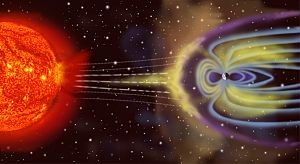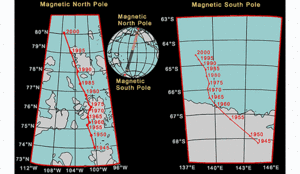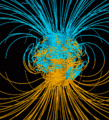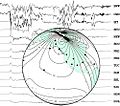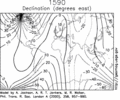Earth's magnetic field facts for kids
The Earth’s magnetic field is like an invisible shield around our planet. It's also called the geomagnetic field.
This magnetic field is made by the Earth's spin and the movement of liquid metal deep inside its core. It protects Earth from harmful particles that come from space. The field isn't always stable; it has changed many times in Earth's long history.
The magnetic field creates magnetic poles, which are close to the geographical poles (the North and South Poles you see on a map). A compass uses this field to help you find directions. Many animals that travel long distances, like birds, also use the Earth's magnetic field to find their way during their yearly migrations. Sometimes, the magnetic poles can even swap places in an event called a magnetic reversal!
Contents
How the Magnetic Field Works
The Earth's magnetic field is created by two main things. First, there are swirling movements (called convective motions) in the hot, liquid metal at the center of the Earth. This liquid metal can conduct electricity.
When these swirling motions happen along with electrical currents flowing around the Earth, they create the magnetic field. The Earth's constant spinning helps keep this magnetic field going. This interaction between the swirling liquid and electrical currents is like a giant dynamo (a machine that makes electricity).
Magnetic Field Strength
The strength of the magnetic field is strongest near the magnetic poles, where the field lines point straight up or down. It's weakest near the equator, where the field lines are more flat or horizontal. The strength of the magnetic field is measured in units called gauss.
Over recent years, the magnetic field has become a bit weaker. In the last 22 years, its strength has dropped by about 1.7% on average. In some places, it has even decreased by up to 10%. This quick drop in strength might be a sign that the magnetic field is getting ready to reverse. A full reversal could happen in the next few thousand years. Scientists have noticed that the movement of the magnetic poles is connected to this decreasing strength.
What is a Geomagnetic Reversal?
A geomagnetic reversal is when the north magnetic pole and south magnetic pole switch places. This has happened many times throughout Earth's history. A reversal happens after the magnetic field's strength drops to almost zero. When the field starts to get stronger again, it builds up in the opposite direction, causing the poles to flip.
Scientists don't know exactly how long a reversal takes, but it could last for up to ten thousand years. The Earth's magnetic reversals are recorded in rocks, especially in a type of volcanic rock called basalt. Scientists believe the last major geomagnetic reversal happened about 780,000 years ago.
The Magnetosphere Shield
The magnetosphere is a huge area around Earth created by its magnetic field. Think of it as a giant shield that protects our planet from harmful particles coming from solar wind (a stream of charged particles from the Sun).
The magnetosphere has many different layers and structures. The solar wind shapes these layers as it interacts with them. This interaction also causes the beautiful Northern and Southern Lights (auroras) that you can sometimes see in the sky near the poles. The magnetosphere is super important for protecting Earth from solar storms, which send out even more solar wind. Solar storms can cause geomagnetic storms, which can sometimes affect things on Earth, like power grids or satellites.
Earth's Magnetic Poles
The invisible lines of the magnetic field connect the north and south magnetic poles. These lines leave the Earth near the South Magnetic Pole and re-enter near the North Magnetic Pole. The exact points where these lines go straight up or down are called magnetic dip poles. These are what we usually call the magnetic poles.
The magnetic poles are not exactly at the Geographic North Pole and Geographic South Pole. The north magnetic pole is currently in the Arctic Circle, at about 78.3 degrees North latitude and 100 degrees West longitude. The south magnetic pole is in Antarctica, at about 78.3 degrees South latitude and 142 degrees East longitude. The magnetic fields are strongest at these pole locations.
North Magnetic Pole
The North Magnetic Pole is the spot in the Earth's northern hemisphere where the planet's magnetic field points straight down. There's only one such spot, and it's close to, but not exactly the same as, the Geographic North Pole.
Its partner in the southern hemisphere is the South Magnetic Pole. Because the Earth's magnetic field isn't perfectly symmetrical, a line drawn between the two magnetic poles doesn't go through the exact center of the Earth.
The North Magnetic Pole actually moves over time. This movement is due to changes happening deep inside the Earth's core. In 2001, it was near Ellesmere Island in northern Canada. By 2015, it had moved further east, beyond Canada's Arctic territory.
Magnetic Field Reversals
The Earth's magnetic poles do switch places, but it happens very slowly, usually every million years or so (give or take 250,000 years). Before the poles flip, the Earth's magnetic field gets weaker and moves around, a bit like a spinning top wobbling before it falls over.
The Earth has had hundreds of these "flip-flops" in the past. Scientists know this by studying the magnetism in rocks on the sea floor, especially near places like the Mid-Atlantic Ridge. Here, hot lava slowly oozes out of cracks in the sea floor. As the lava cools, tiny iron oxide molecules inside it line up with the Earth's magnetic field at that time. By looking at these rocks, scientists can see a record of all the past magnetic flips.
These reversals don't happen on a regular schedule. They can be as close as 0.1 million years apart or as far as 50 million years apart. The most recent major reversal, called the Brunhes–Matuyama reversal, happened about 780,000 years ago. There was another smaller, shorter event called the Laschamp event about 41,000 years ago during the last ice age, but it wasn't a full reversal.
Animals and the Magnetic Field
Animals that travel long distances, like birds, turtles, and fish, might use the Earth's magnetic field to help them find their way. This is called magnetoreception.
Some migratory animals can sense their location by feeling the strength of the magnetic field. They might also use the field to help them keep track of time, thanks to their internal body clocks (called circadian rhythms). Many migratory animals are born with a kind of "magnetic map" in their brains. This map helps them travel safely over huge distances. Their ability to sense the magnetic field might come from tiny magnetic particles in their bodies. Other animals might have a "chemical compass" that uses special chemical reactions to detect the field.
Images for kids
-
A computer picture showing Earth's magnetic field when it's in a normal state, between reversals. The lines show the magnetic field lines. Blue means the field points towards the center, and yellow means it points away. The Earth's spin axis is in the middle and points up. The thick groups of lines are inside Earth's core.
See also
 In Spanish: Campo magnético terrestre para niños
In Spanish: Campo magnético terrestre para niños


